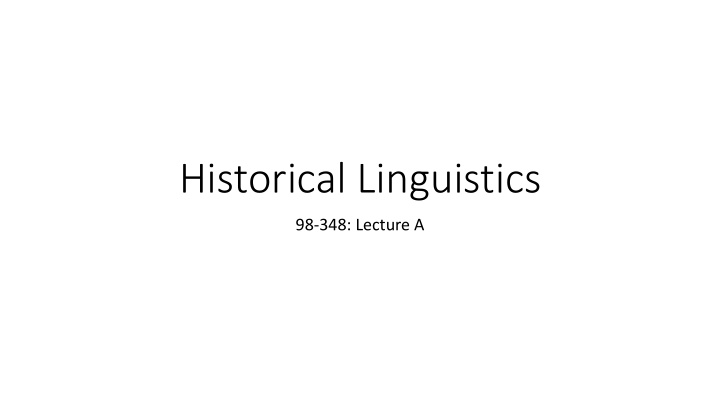



Historical Linguistics 98-348: Lecture A
Goal for today: understand this
How does a language emerge? • Did we just start speaking English starting at some point in history??? • Obviously, no • The same applies to OI: Something → OI → Something else • Although this person (kind of) claims the opposite
Does language change? How soon hath Time the suttle theef of youth Stoln on his wing my three and twentith year! My hasting dayes flie on with full career, But my late spring no bud or blossom shew’th . – John Milton, Sonnet VII • Try and find evidence for: • Phonological change: change in sound? • Morphological change: change in forms of words? • Syntactic change? Semantic change?
Languages do change • But does each language change in isolation? • Could different languages be related to each other in some way?
Here’s some data What do you notice? English French Italian Spanish Portuguese dear cher caro caro caro field champ campo campo campo candle chandelle candela candela candeia house chez casa casa casa
This French Italian Spanish Portuguese ch /ʃ/ c /k/ c /k/ c /k/ English French Italian Spanish Portuguese dear cher caro caro caro field champ campo campo campo candle chandelle candela candela candeia house chez casa casa casa
Evidence for genealogical relationships between languages • Certain languages are similar, or systematically different • This is true especially wrt to sound (phonology): Systematic correspondences between sounds across languages French Italian Spanish Portuguese ch /ʃ/ c /k/ c /k/ c /k/ • These languages must have once shared a common ancestor! They then took on different sound changes and diverged into different languages.
Comparative method French Italian Spanish Portuguese • We look at correspondence sets cher caro caro caro like this and determine how the champ campo campo campo languages diverged. chandelle candela candela candeia chez casa casa casa • Two things to figure out: • How do the trees branch? i.e. in what order did the languages branch out? • What does each node look like? i.e. what sounds did the languages at each node have?
Choosing trees Fr. It. Sp. Po. ch /ʃ/ c /k/ c /k/ c /k/ 1 3 2
Choosing what each node looks like • How do we know if there’s a /ʃ/ ? or a /k/ in the ancestor? • Hint: what language could this ancestor be? /ʃ/ /k/
Latin is a good choice • We know that Latin candela has a /k/ sound • So the Latin /k/ was preserved in Italian, Spanish and Portuguese, but changed into /ʃ/ in French
Now this diagram makes much more sense! (…or does it?) What are these “ proto-languages ”? We know what’s going on here
Konungr in the Scandinavian languages
Proto-languages: when the ancestor is unattested • We need to construct a proto-language and a proto-form • Example: British vs. American medial t : • atom ([a t əm ] vs. [æ ɾ əm ]), bitter , little … • Evidence for Proto-English * t ? • Counterevidence for that (does not entail that Proto-English has ɾ )?
Choosing the ”right” proto -form for A and B • Frequency • Does A → B occur more often than B → A across languages, or vv.? • ” Elsewhere ” -hood • Does A seem to be the general, ” elsewhere ” case, or does B seem so?
Be careful about picking your evidence American English: German: dog / dɔɡ / Hund / hʊnt / Mbabaram: dog / dɔɡ /
What next? • Look at how Proto-Germanic developed into OI
Recommend
More recommend